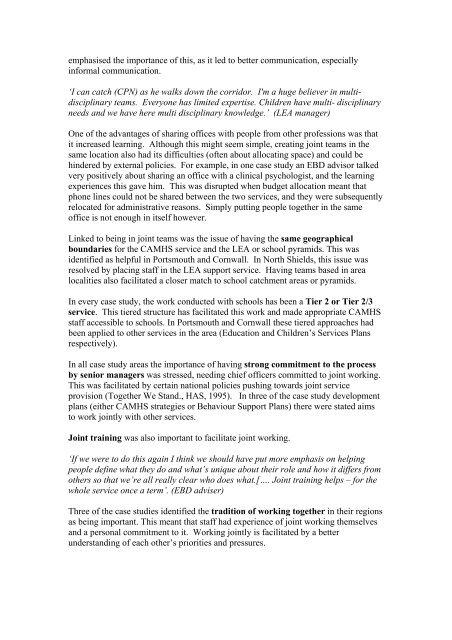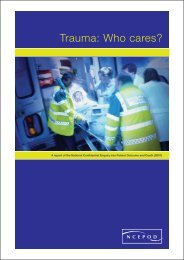(CAMHS) and Schools - London Health Programmes
(CAMHS) and Schools - London Health Programmes
(CAMHS) and Schools - London Health Programmes
You also want an ePaper? Increase the reach of your titles
YUMPU automatically turns print PDFs into web optimized ePapers that Google loves.
emphasised the importance of this, as it led to better communication, especially<br />
informal communication.<br />
‘I can catch (CPN) as he walks down the corridor. I'm a huge believer in multidisciplinary<br />
teams. Everyone has limited expertise. Children have multi- disciplinary<br />
needs <strong>and</strong> we have here multi disciplinary knowledge.’ (LEA manager)<br />
One of the advantages of sharing offices with people from other professions was that<br />
it increased learning. Although this might seem simple, creating joint teams in the<br />
same location also had its difficulties (often about allocating space) <strong>and</strong> could be<br />
hindered by external policies. For example, in one case study an EBD advisor talked<br />
very positively about sharing an office with a clinical psychologist, <strong>and</strong> the learning<br />
experiences this gave him. This was disrupted when budget allocation meant that<br />
phone lines could not be shared between the two services, <strong>and</strong> they were subsequently<br />
relocated for administrative reasons. Simply putting people together in the same<br />
office is not enough in itself however.<br />
Linked to being in joint teams was the issue of having the same geographical<br />
boundaries for the <strong>CAMHS</strong> service <strong>and</strong> the LEA or school pyramids. This was<br />
identified as helpful in Portsmouth <strong>and</strong> Cornwall. In North Shields, this issue was<br />
resolved by placing staff in the LEA support service. Having teams based in area<br />
localities also facilitated a closer match to school catchment areas or pyramids.<br />
In every case study, the work conducted with schools has been a Tier 2 or Tier 2/3<br />
service. This tiered structure has facilitated this work <strong>and</strong> made appropriate <strong>CAMHS</strong><br />
staff accessible to schools. In Portsmouth <strong>and</strong> Cornwall these tiered approaches had<br />
been applied to other services in the area (Education <strong>and</strong> Children’s Services Plans<br />
respectively).<br />
In all case study areas the importance of having strong commitment to the process<br />
by senior managers was stressed, needing chief officers committed to joint working.<br />
This was facilitated by certain national policies pushing towards joint service<br />
provision (Together We St<strong>and</strong>., HAS, 1995). In three of the case study development<br />
plans (either <strong>CAMHS</strong> strategies or Behaviour Support Plans) there were stated aims<br />
to work jointly with other services.<br />
Joint training was also important to facilitate joint working.<br />
‘If we were to do this again I think we should have put more emphasis on helping<br />
people define what they do <strong>and</strong> what’s unique about their role <strong>and</strong> how it differs from<br />
others so that we’re all really clear who does what.[…. Joint training helps – for the<br />
whole service once a term’. (EBD adviser)<br />
Three of the case studies identified the tradition of working together in their regions<br />
as being important. This meant that staff had experience of joint working themselves<br />
<strong>and</strong> a personal commitment to it. Working jointly is facilitated by a better<br />
underst<strong>and</strong>ing of each other’s priorities <strong>and</strong> pressures.

















